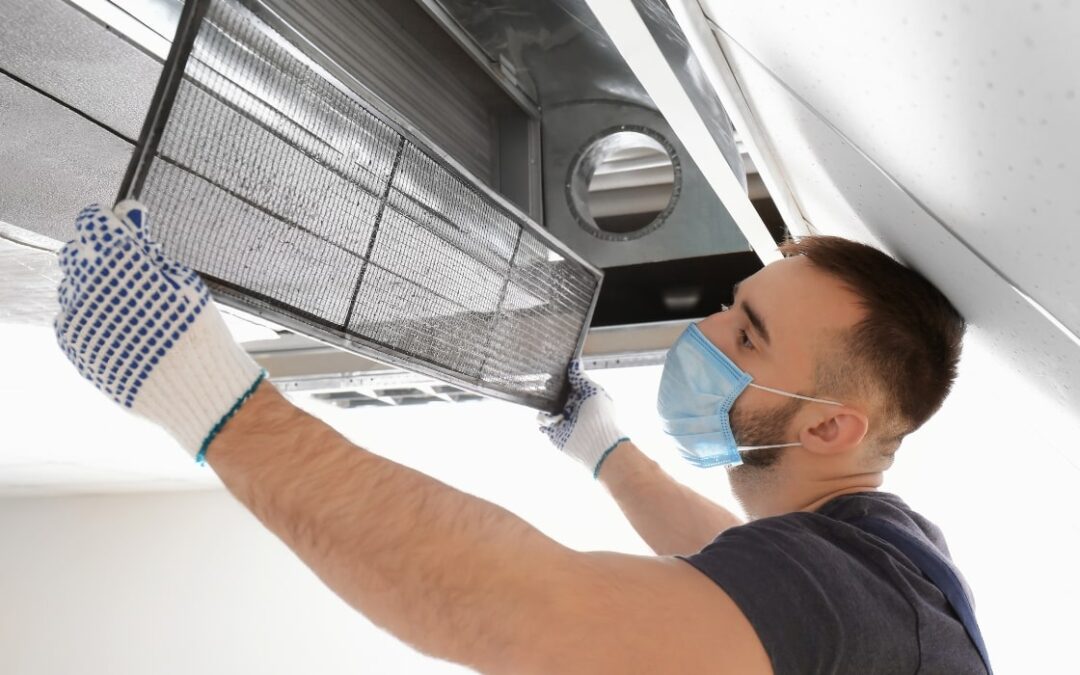Heating, Ventilation and Air-Conditioning solutions are an essential part of any home or commercial property, which could include office blocks, schools, hospitals, hotels and more. Essentially, HVAC systems allow you to maintain a comfortable indoor environment set to your desired temperature while ensuring the air remains clean and safe. In this guide, we’ll detail the HVAC basics you need to be aware of, such as the history of their development and how to choose the correct system for your building.

What Is an HVAC System?
HVAC solutions come in many forms. In hot climates, HVAC systems usually work to cool the air inside your building by expelling warm air outside. In temperate climates, HVAC solutions typically do the opposite; pumping hot air throughout your building to keep your employees, household members and equipment warm. In areas that experience extreme temperature fluctuations, HVAC solutions can either cool or heat the interior of a property.
A Brief History of Ancient HVAC Systems
HVAC solutions have a long history. Primitive forms have existed for millennia. Between the years 1000 and 1400, Romans, Indians, Greeks and Egyptians had ways to cool themselves as well as the interiors of their buildings. While the Egyptians used man-powered fans, the Indians utilized rope fans. Romans used what was known as a hypocaust, which consisted of a basement-based furnace to distribute heat through flues. Towards the end of the 15th century, Leonardo Di Vinci invented water-driven fans to add ventilation to rooms.
HVAC Basics: How They Work
You can think of an HVAC solution as a building’s equivalent to your body’s respiratory system. HVAC solutions control the quality and movement of air to either heat or cool as well as ventilate the air inside a building. Primarily, an HVAC system works by heating air or water when they meet a heating element or refrigerant. This cooled or heated air is pushed through ducts by fans and allowed to escape into rooms via vents. Correctly installed HVAC systems help prevent a build-up of CO2 while introducing fresh air into a structure and maintaining a constant temperature.
The Different Types of Modern HVAC System
HVAC solutions have come a long way since the early systems from the medieval era. The technology behind HVAC basics has evolved significantly, especially since the 1900s. Now, there are many different types of heating and cooling systems available, namely:
-
Split HVAC systems
These units have components installed inside and outside a building, and they’re usually straightforward to operate and take little time to set up. Its main components include AC units, a thermostat, evaporator coils and ducts. They may also feature air cleaners, UV lamps and humidifiers.
-
Duct-free HVAC solutions
If it’s too challenging to install a system with ducts, you can heat and cool your property with a duct-free solution, which features a control panel with a thermostat and wires, an air conditioner, a compact fan coil and tubing.
-
Hybrid systems
One of the most energy-efficient HVAC systems, hybrid solutions comprise a heat pump, refrigerant, evaporator coils and a furnace. They’re best suited to properties that experience extreme winters.
-
Packaged air-conditioning and heating solutions
You can heat and cool a building with one of these systems, which, just like those detailed above, feature heat pumps, air conditioners, control systems with a thermostat and an evaporator. They’re a popular choice for people living in areas that are prone to extreme climate fluctuations.
You can also purchase and install window AC systems, but they’re only suitable for cooling compact spaces rather than large areas.
Deciding on the Right HVAC System for Your Property
Factors you should consider when choosing the right HVAC solution for your unique requirements include:
- The size of your system: If a system is too small for your property, it’ll work harder to achieve your desired temperature, thereby increasing your energy usage and causing components to wear faster.
- Choose a local installer: Avoid purchasing and installing systems and components that nobody in your area can service or replace to prevent maintenance costs from spiraling out of control.
- Prioritize energy efficiency: Heating and cooling can account for more than half your energy costs, so choose an HVAC system with a high energy rating.
- Go for quality over affordability: Choosing a cheap model won’t necessarily help you save money in the long run if you need repairs continuously.
- Seek professional advice: The easiest way to ensure the most suitable HVAC solution is installed in your home is to obtain honest advice from a highly experienced supplier that works with all brands rather than promotes an individual manufacturer.
Smarter HVAC Solutions Are Changing the Game
Here’s something a lot of folks miss when choosing HVAC systems—smart tech is no longer just a “nice to have.” In 2025, smart thermostats and zoned HVAC systems are driving the way we heat and cool our spaces more efficiently. Imagine controlling your indoor climate right from your phone or setting up a schedule that cools just the rooms you use—like your bedroom at night or the kitchen during the day. Zoned systems let you heat and cool specific areas of your property independently, helping you slash energy bills and reduce unnecessary wear on your HVAC unit. This is especially helpful in larger homes or commercial buildings with multiple occupancy zones.
Even better? Most smart HVAC solutions come with real-time energy consumption analytics, allowing you to monitor performance and spot issues before they become expensive headaches. In fact, a 2024 Energy Star report found that users with smart HVAC systems saved up to 23% annually on their heating and cooling costs. That’s a win for your wallet and the planet.
The Overlooked Importance of Regular HVAC Maintenance
Let’s be honest—nobody gets excited about HVAC maintenance, but skipping it is like never changing the oil in your car. Dust buildup, clogged filters, and low refrigerant levels can kill your system’s efficiency and tank your indoor air quality. Poorly maintained HVAC systems can circulate allergens, bacteria, and even mold spores throughout your home. That’s not just gross—it’s a serious health risk, especially if you have asthma or allergies.
Want your HVAC solution to last longer and run like a dream? Schedule seasonal tune-ups, swap out your filters every 30 to 90 days, and have your ductwork inspected annually. This isn’t just good advice—it’s essential. According to a 2023 report by the U.S. Department of Energy, regular HVAC maintenance can extend system lifespan by up to 40% and improve overall air circulation and indoor comfort.
HVAC Basics: Conclusion
Getting your head around the complexities of HVAC solutions is challenging to say the least, so before you invest in a system, ask a trained and qualified professional for advice and a site visit. If you have any questions about the HVAC basics, don’t hesitate to call us, and we’ll provide more information telephonically.



